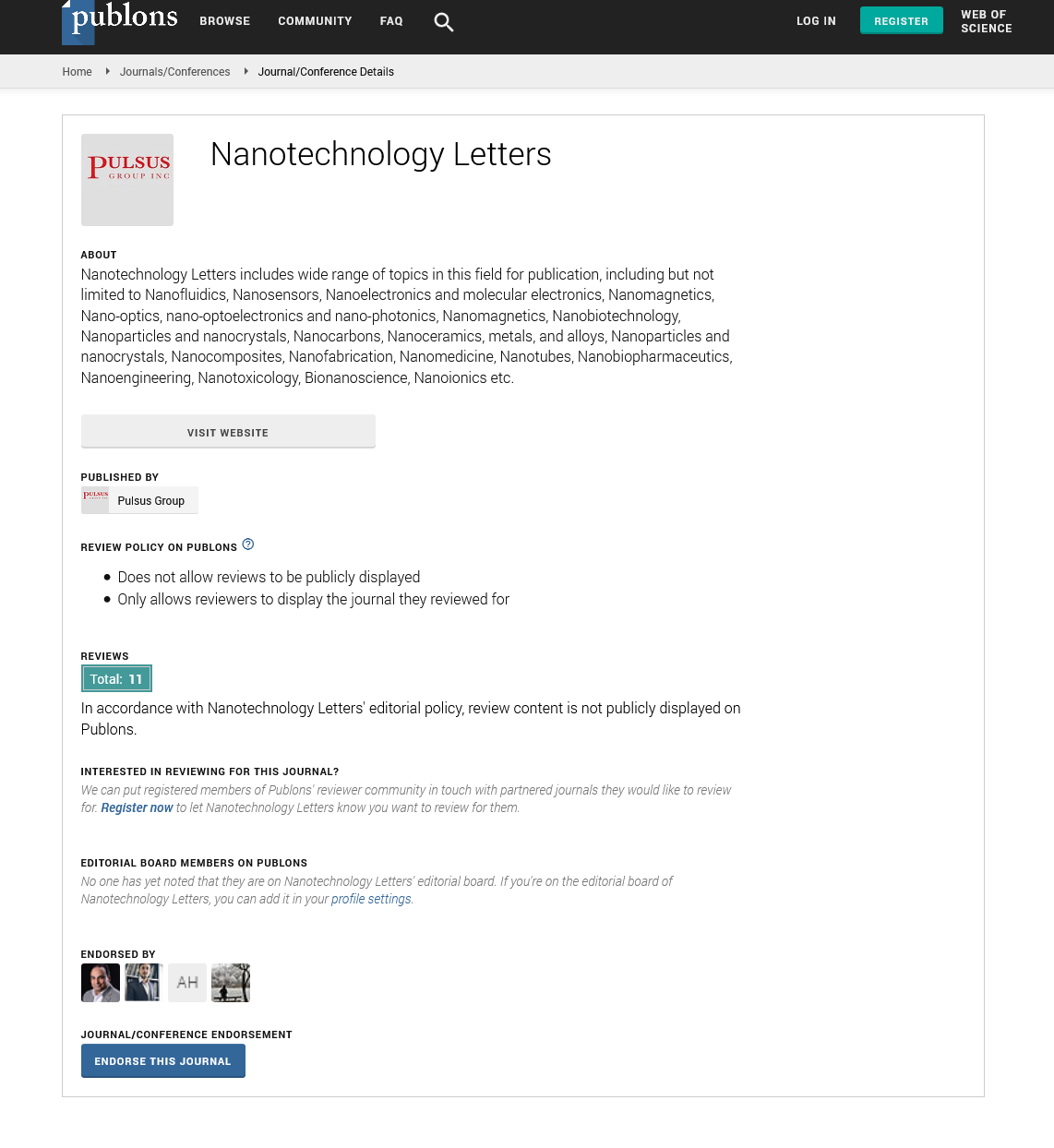Integration of microfabrication into biological investigations
Received: 06-Jul-2022, Manuscript No. PULNL-22-5578; Editor assigned: 08-Jul-2022, Pre QC No. PULNL-22-5578 (PQ); Accepted Date: Jul 26, 2022; Reviewed: 12-Jul-2022 QC No. PULNL-22-5578(Q); Revised: 15-Jul-2022, Manuscript No. PULNL-22-5578 (R); Published: 27-Jul-2022, DOI: 10.37532. pulnl.22.7 (4).03-04.
Citation: Watson S. Integration of microfabrication into biological investigations. Nanotechnol. lett. 2022;7(4):03-04.
This open-access article is distributed under the terms of the Creative Commons Attribution Non-Commercial License (CC BY-NC) (http://creativecommons.org/licenses/by-nc/4.0/), which permits reuse, distribution and reproduction of the article, provided that the original work is properly cited and the reuse is restricted to noncommercial purposes. For commercial reuse, contact reprints@pulsus.com
Abstract
Microfabrication, one of the earliest micro- and nanotechnologies, has had an impact scientific discovery has resulted in significant real-world applications, as seen by technical revolutions in the past. Several significant sectors that are benefited by invention and development Biological and biomedical platforms are a subset of microfabrication platforms. modern medical point-of-care, precision medicine, and customised medical techniques are replacing the testing stage before becoming the norm for medical treatment. Additionally, biological research microfluidics makes contributions at all levels, from single cells to tissue engineering and research on organoids. A multidisciplinary approach is utilised to create breakthrough biological technologies and highlight the importance of technical expertise in enabling researchers who are experts in a certain field to explore beyond both and innovate.
Key Words
Microfabrication; Biomedical engineering
Introduction
The overwhelming system-level complexity of biological networks and the spatiotemporal integration of their multiscale and multiparametric components limit our comprehension of physiological functions and disease states and, consequently, our capacity to devise efficient therapeutic solutions. Biologists have created a sizable arsenal of complementary strategies to deal with such complexity. In the past, biologists have favoured reductionist experimental designs where each experiment is designed to investigate a single parameter . In this article, I will outline the technological background of the current technological revolution in biological research and talk about the elements that made such advances possible. Following that, we will provide examples of some of our own significant discoveries that resulted from close interaction and collaboration amongst scientists with many fields of expertise working together under one roof.
A brief historical perspective: Development of microfabrication for biological research
The necessity to scale down the size of micro-components has been the main impetus for the development of micro/nano technologies for the better part of the last 70 years. As a result, microchips with more computing capacity and often lower power consumption have been developed. This race has resulted in an amazing technical revolution that our age has seen. More intriguingly, Moore's law has been kept up with by the development of new technologies and the application of novel strategies for the patterning of small features on a large-scale flat substrate.This was accomplished by utilising ultraviolet (UV) light with a decreasing wavelength in , In order to increase the resolution of the features, a 1:1 contact printing approach was first used, then Picture reduction was made possible using image projection and step-andscan exposure techniques via means of an optical system .
Bridging Biologists and Engineers
As a branch of the life sciences, biological research adopts the scientific method, thereby hypotheses are formulated to address scientific questions and experiments are designed to draw factual conclusions that verify the original hypotheses. In this process, a key bottleneck is the design of adequate experiments that can provide feasible strategies and satisfy rigorous scientific standards. Two courses of action are feasible in this regard: researchers resort to commercially available instrument, devices and packaged kits when available. Alternatively, in the absence of commercial solutions, biologists adopt an interdisciplinary approach and devise the necessary enabling tools by collaborating with engineers . Along with commercial viability, choosing between the two options may also be influenced by a wide range of factors, including standardisation, time and cost efficiency, feasibility, and the need to tailor the experiment, to mention a few. According to our observations, the researcher's propensity for creativity, which results in the creation of fresh technologies, also affects their preference for one solution over another. Nowadays, researchers have access to an extensive toolbox of instruments, devices and experimental kits that can be purchased from specialized biotech companies. Thus, once they identify the biological parameter that needs to be quantified, scientists can search for commercially available and adopt them into their research workflow. This path of least resistance offers multiple advantages, such as being time- and cost-effective. Furthermore, mass-produced commercial products are standardized in accordance to international standards for good manufacturing practice and are supplemented with detailed operating protocols. Additionally, commercial solutions go through extensive validation processes carried out by many users over a long period of time, which increases the reliability of the results that they generate and the understanding of possible pitfalls. knowledge of the device´s engineering aspects, an ideal situation for biomed specialists who can devote their time to perform experiments and produce quality results. Obviously commercial products also come with their inherent limitations.
Use of Microfabrications for Biological Investigations There are numerous instances of micro-fabricated products or microfabrication-based technologies that have been modified for use in biomedical applications. On one side, there is a lengthy a list of studies that use simple micro-fabrication, where simple is defined as "established and generally accepted micro-fabrication processes" in this context. The following sections will highlight three sample cases where freshly developed micro-fabricated devices offered a novel platform to address unresolved biological concerns in order to better illustrate this argument.
They are as follows:
1. soSPIM: a light sheet microscopy system that needs only one single objective with high numerical aperture owing to the use of microfabricated disposable chips; 2. IR-live: a microfluidic platform for label-free chemical imaging of live cells by infra-red absorption spectroscopy; 3. Microfabricated microwells for expansion of Circulating Tumor Cells (CTC).






